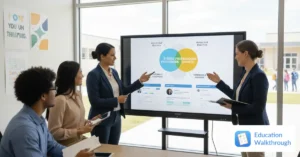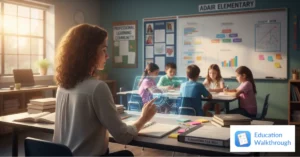Hey there, fellow educators! Let’s chat about something close to our hearts: teaching. But not just any teaching—the kind that actually sticks, the sort that gets our students fired up about learning. We’re diving into the essential elements for effective classroom instruction, because, let’s face it, we all want to be that teacher—the one students remember for years to come. So grab your coffee, and let’s get down to the nitty-gritty of teaching strategies, student engagement, and the magic that turns a classroom into a powerhouse of knowledge and creativity.
The Big Picture: What Makes Great Teaching?
Before we get into the specifics, let’s talk big picture. Great teaching is kind of like a recipe. It’s a blend of ingredients—some you absolutely need, and others that add that special flavor. And just like in cooking, the quality of the ingredients matters—a lot.
Great teaching comes down to a few key elements: clarity, enthusiasm, interaction, and relevance. When these ingredients are in the mix, you’ve got a recipe for success. But let’s not stop there; let’s break down these components and see how we can whip up some educational excellence.
Ingredient #1: Clarity in Communication
Speaking Their Language
First up, clarity. We’re talking about speaking the language of our students—literally and figuratively. It’s about breaking down complex ideas into bite-sized pieces they can digest. But it’s not just about simplifying; it’s about being precise. If we’re not clear, we’re just the adults from the Peanuts cartoons—wah wah, wah wah wah.
The Power of Examples
And hey, examples are our friends. They’re like the GPS for our students, guiding them through unfamiliar territory. Whether it’s a math problem or a historical event, examples illuminate the path to understanding.
Ingredient #2: Engagement and Enthusiasm
Passion is Contagious
Now, onto the spice that really makes a lesson pop—enthusiasm. If we’re not jazzed about the subject, why should our students be? Our passion is contagious, and it can turn the driest subject into an adventure. So channel your inner performer, and let’s make those students sit on the edge of their seats!
Keeping Students on Their Toes
And while we’re at it, let’s mix it up. Different activities keep students engaged. Think pair-share, group projects, or even a good old-fashioned debate. The key? Keep ’em guessing, keep ’em engaged.
Ingredient #3: Interaction and Involvement
It’s a Two-Way Street
Interaction is where the magic happens. It’s not just about us talking at them; it’s a dialogue. When students are involved in their learning, they’re like detectives solving a mystery—they’re invested, and they remember.
The Art of Questioning
Questions are the arrows in our quiver here. Good questions spark curiosity and get those gears turning. And it’s not just about asking them; it’s about encouraging students to ask their own. That’s when we know we’ve struck gold.
Ingredient #4: Relevance and Real-World Connections
Linking Lessons to Life
Last but not least, relevance. This is about showing our students why what they’re learning matters. It’s connecting the dots between the classroom and the world beyond. When they see that link, that’s when the learning really sticks.
Bringing the Outside In
Let’s bring the outside world into our classrooms. Guest speakers, field trips, or even a news article can show students that what they’re learning isn’t just confined to textbooks—it’s happening right now, out there in the big wide world.
Advanced Techniques: Differentiation and Assessment
Meeting Students Where They Are
Now, for those looking to take their teaching to the next level, let’s talk differentiation. It’s about tailoring our teaching to meet the needs of every student—because one size definitely does not fit all in education. It might mean more work, but seeing every student thrive? Worth it.
The Feedback Loop
Assessment isn’t just about grades; it’s about feedback. And feedback is like the compass that guides our teaching. It tells us what’s working and what’s not, so we can adjust our course and keep our students on track.
The Classroom Environment: A Space for Learning
Setting the Stage
The environment we create in our classroom is the stage for our teaching. It should be inviting, it should be safe, and it should be a place where mistakes are just stepping stones to learning.
Technology as a Tool
image_steps(A teacher using technology as a tool for engaging students in the classroom)
And let’s not forget about technology. When used right, it’s a powerful tool that can enhance our teaching and captivate our students. But it’s just that—a tool. It’s not the star of the show; that’s still us, folks.
The Role of Reflection in Teaching
Learning from Experience
Lastly, let’s talk reflection. Taking the time to reflect on our teaching is like hitting the pause button. It gives us the chance to celebrate our wins and learn from our misses. It’s how we grow as educators.
Continuous Improvement
And remember, effective teaching is a journey, not a destination. There’s always room for improvement, always a new strategy to try. So let’s keep learning, keep experimenting, and keep inspiring.
Wrapping It Up
So there you have it—the essential elements for effective classroom instruction. It’s about clarity, enthusiasm, interaction, relevance, differentiation, assessment, environment, technology, and reflection. Phew! That’s quite the list, but we’ve got this.
As teachers, we have the power to make a difference every single day. By focusing on these elements, we can create a classroom where learning is alive, where students are engaged, and where education is not just about memorizing facts—it’s about igniting a love for learning that lasts a lifetime.
Here’s to us, the shapers of minds and the builders of the future. Let’s make it count!




